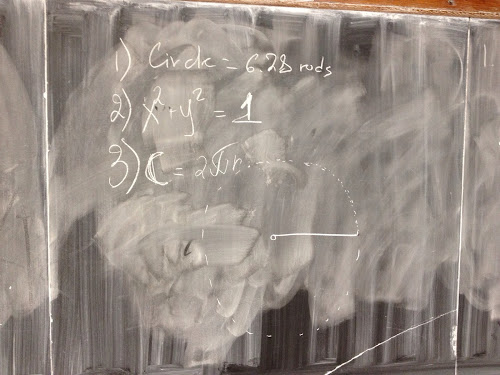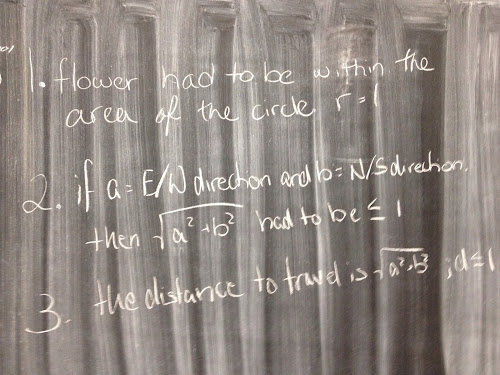Trigonometric storytelling, Part 1
December 6, 2012
We’ve just had a good week-plus of precalculus lessons built around a story, inspired by Daniel Willingham’s tweet and the article by Julie DeNeen about which he tweeted.
[embedit snippet=”willingham-tweet”]
The tweet came at an opportune time. It was Thanksgiving break, I was away from home, and didn’t have much that needed to get done for a couple of days, so I felt like I had the time to be creative. The upcoming topic in precalculus was the unit circle, so I decided to see if I could come up with an appropriate story. (I have a colleague who tells a unit circle story about a cockroach, which gave me hope that I, too, could develop a story on this theme.) Over the course of the long Thanksgiving weekend I figured out the basic plot and developed the details of the opening act, which I would tell in our first class after Thanksgiving. The students would need a couple of class periods to do some work on the ideas introduced in this first act, and so I had a few more days to develop the details for the end.
We have one 75-minute period each week and three 45-minute periods. We returned to school after Thanksgiving on Tuesday, when we have our 75-minute period. The storytelling this day took about 5 minutes. Here’s the part of the story that I told on that day:
This is Girt:
At this point, I stopped and, ignoring pleas to go on, announced that we were going to need to do some work before I could finish the story. I broke the students up into pairs (by giving half of the students cards with graphs of parabolas and the other half equations of those parabolas and telling them to find their mates) and distributed a handout. I pointed out that the handout listed the locations of some flowers in relation to the post on which Girt’s rod pivoted and asked each pair to determine which of these flowers Girt would be able to reach.
The pairs dove into the task. A few asked some clarifying questions. They started to visualize the situation and realized the task amounted to figuring out whether the points given fell on a circle. I told them they had to work without calculators until they’d made decisions about all of the flowers except those whose coordinates were given as decimals. Everyone was able to make some decisions fairly quickly about a few of the points, but it was not immediately obvious to the vast majority about how to proceed for most of the points. One pair asked for a compass. Several pairs decided to approach it entirely with graph paper and circles sketched without the aid of a compass. Several pairs recognized that the equation of a circle would be helpful, but couldn’t remember what it was and, when I wouldn’t tell anyone what it was, most abandoned that tack. A couple of individuals were able to come up with the equation for a circle and they made rapid progress (as did some nearby pairs who were listening in when they sensed progress from others). I overheard still others saying things like “Can they both be under 1?” and “If this one’s close to 1, the other one has to be close to 0.”
While most students in the class had no previous experience with the unit circle, a few did, and most of these–sooner or later–realized there was a connection of some sort. One of those had a good enough grasp of the unit circle already that he and his partner (who, was incidentally, the groaner mentioned above) made a lot of progress early on (and the groaner asked before long, “Oh–are the Cartesian plane and the x-y plane the same thing?”) Another who had some recollection of the unit circle from his math class last year called across the room to a student who had been in class with him last year, “Do you remember that circle thing we did last year?” His friend replied, “I remember NOTHING from last year!” In a couple of cases when I sensed that a pair had made a good amount of progress, but was starting to reach a stage of frustration, I encouraged them to draw a right triangle for one of the flowers that they had determined was on the circle and to think about the Pythagorean Theorem. For most who needed help, this was sufficient to spur them to the understanding that they needed to check whether the sum of the squares of the coordinates was 1, and from there they were able to make rapid progress.
While some finished determining which flowers Girt could reach much earlier than others, the final question on the handout about how far she had to travel to reach each flower kept those who finished early very engaged until everyone had an opportunity to determine which flowers Girt could reach. The question about how far she had to travel made people grapple with the difference between location and path length. A typical conversation between partners went like this,
“What are we trying to figure out now?”
“How far she went to get to the flower.”
“But we know how far she went.”
“We know the coordinates, but we don’t know how far she went to get there.”
By the end of about an hour, everyone had spent some time on this final question. Around this point, I passed near a pair and was flagged down, “Laura, why do you do this to us?” “What?” “Make us think!” I walked past another pair and overheard “Oh, that makes sense! When she’s due west, it’s 3.14.” When everyone figured out, at a minimum, that Girt had to travel π rod-lengths to get from her starting point 1 rod east of the post to the flower that was 1 rod west of the post, I sent everyone to the board and asked each pair to write three observations, things they had discovered, or things that would have been helpful to know. Here’s what they wrote
Not perfect, but–wow–had they discovered a lot in an hour! Finally, I scrambled the pairs, and asked new partners to check their results about which flowers Girt could reach. One pair wrote their agreed-upon results on the board and I asked for objections to any of the results. One person objected to several of the posted answers, but others were ready to defend all of the posted answers vigorously. I asked the objector if she happened to be from the pair who had used inequalities in the observations they had written on the board. When she said yes, I explained that Girt was stuck to the very tip of an inflexible rod, and she immediately said, “Oh, we misinterpreted the problem” and, after looking at her calculations in light of this new information, withdrew her objections.
As we ran out of time, while all were eager to get to lunch, several couldn’t believe that they weren’t going to get to hear the end of the story yet, and even after 75 minutes of math, would have been willing to stick around a few more minutes to hear it. I told them we weren’t finished all the work we needed to do before we could get to the end.
–“How are we going to be able to sleep with poor Girt stuck to that rod?”
–“I guess you’ll just have to come back tomorrow!”
I can’t be sure that they know any of this better than they would have if we’d covered the same concepts without a story, but they’ve left me with the impression that they do. It’s obvious, at least, that they did virtually all of the abstraction on their own. I just told them that a worm (about whom they’d come to care a bit) was stuck to a rod, and then introduced the familiar abstraction of North/South and East/West coordinates for a bunch of flowers. Then they worked hard for an hour and were able to articulate important ideas related to the unit circle. There is absolutely no question in my mind that the narrative made most of them more interested and willing to play along than they otherwise might have been.
(I will post about the classes that followed–and tell the end of the story–before too long, I hope.)









